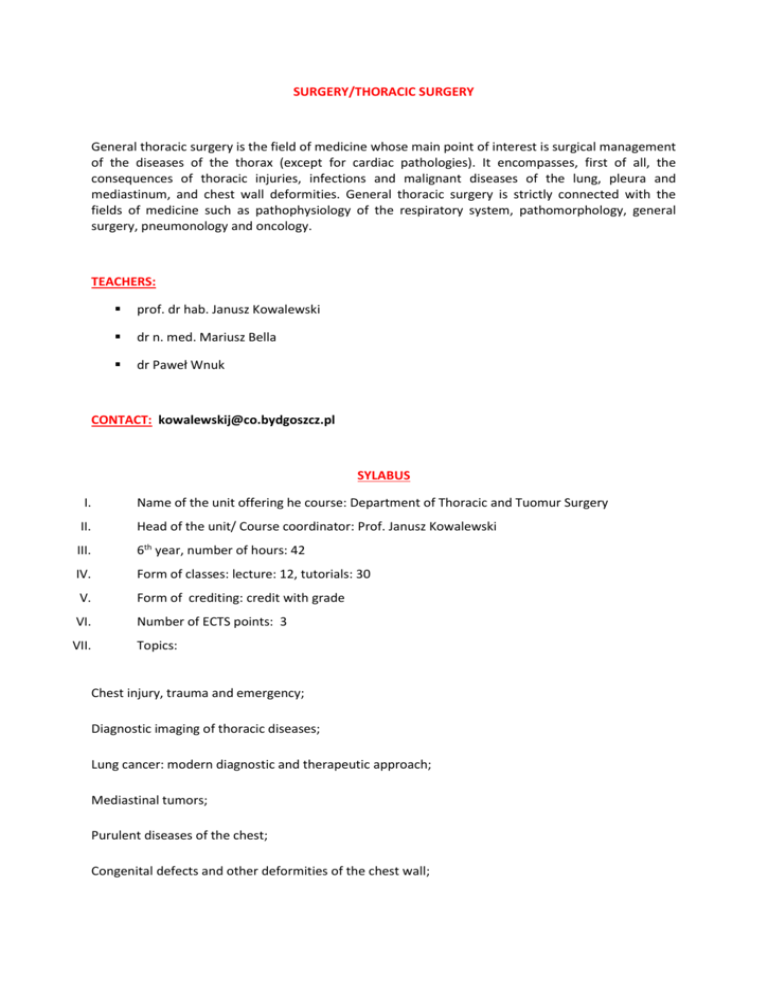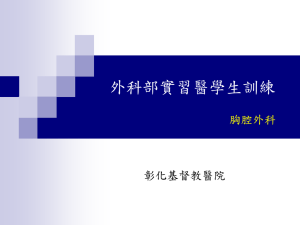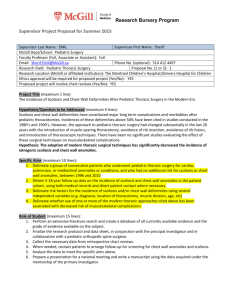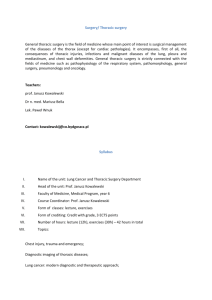Surgery/Thoracic Surgery
advertisement

SURGERY/THORACIC SURGERY General thoracic surgery is the field of medicine whose main point of interest is surgical management of the diseases of the thorax (except for cardiac pathologies). It encompasses, first of all, the consequences of thoracic injuries, infections and malignant diseases of the lung, pleura and mediastinum, and chest wall deformities. General thoracic surgery is strictly connected with the fields of medicine such as pathophysiology of the respiratory system, pathomorphology, general surgery, pneumonology and oncology. TEACHERS: prof. dr hab. Janusz Kowalewski dr n. med. Mariusz Bella dr Paweł Wnuk CONTACT: kowalewskij@co.bydgoszcz.pl SYLABUS I. Name of the unit offering he course: Department of Thoracic and Tuomur Surgery II. Head of the unit/ Course coordinator: Prof. Janusz Kowalewski III. 6th year, number of hours: 42 IV. Form of classes: lecture: 12, tutorials: 30 V. Form of crediting: credit with grade VI. Number of ECTS points: 3 VII. Topics: Chest injury, trauma and emergency; Diagnostic imaging of thoracic diseases; Lung cancer: modern diagnostic and therapeutic approach; Mediastinal tumors; Purulent diseases of the chest; Congenital defects and other deformities of the chest wall; The importance of minimally invasive surgery and palliative care in thoracic surgery; VIII. Booklist: Thomas W. Shields. General Thoracic Surgery. Seventh Edition 2009. Brief description: General thoracic surgery is the field of medicine whose main point of interest is surgical management of the diseases of the thorax (except for cardiac pathologies). It encompasses, first of all, the consequences of thoracic injuries, infections and malignant diseases of the lung, pleura and mediastinum, and chest wall deformities. General thoracic surgery is strictly connected with the fields of medicine such as pathophysiology of the respiratory system, pathomorphology, general surgery, pneumonology and oncology. Full description: The classes of general thoracic surgery at the Faculty of Medicine, NCU are delivered in the form of lectures and practical excercises. Subjects of lectures: 1. Thoracic trauma (two lectures). The purpose of the lectures is to present the life threatening consequences of thoracic trauma (tension pneumothorax, sucking chest wound, flail chest, cardiac tamponade, injuries of great vessels or trachea) and potentially life threatening ones (oesophageal and diaphragmatic injuries, pulmonary contusion, mediastinitis). The mechanisms of cardiopulmonary disturbances accompaning thoracic trauma and methods of thoracic injuries management and their timing are discussed in details. Indications and the technique of chest tube insertion, therapeutic thoracentesis and pericariocentesis are also presented during the lecture. 2. Carcinoma of the lung (two lectures). The etiology, clinical presentation, diagnostic methods and the management of lung cancer dependently on its staging are presented in the lecture. The surgical aspect of the malignancy is discussed especially thoroughly (bronchoscopy, videothoracoscopy, surgical lung resections and combined therapy) 3. Suppurative thoracic diseases (two lectures). The lectures acquaint students with the diagnosis and management of lung abscess, pleural empyema, bronchiectasis and mediastinitis. 4. Imaging diagnostic studies in thoracic diseases. The lecture presents contemporary imaging techniques for diagnosis of trauma, malignancies and inflammatory diseases of the chest (x-ray, CT, MRI, PET/CT, bronchoscopy) 5. Solitary pulmonary nodule. Definition of solitary pulmonary nodule, its etiology and diagnostic management. 6. Tumours and cysts of the mediastinum. The lecture familiarizes students with the definition and compartments of the mediastinum and the terminology of mediastinal tumours and psedotumors. Thymomas, teratomas, germinal tumours, neurogenic tumours, retrosternal and mediastinal goitre are discussed in details. 7. Minimally invasive thoracic surgery. The indications for and technique of mediastinoscopy, videothoracoscopy,VATS, bronchoscopy, AFI bronchoscopy and EBUS are presented. Separate types of procedures performed with the aforementioned techniques are discussed. 8. Palliative thoracic surgery. The lecture presents the strategy of management in the cases of recurrent malignant pleural effusion, malignant stenosis of the trachea, main bronchi and oesophagus, and thoracic pain caused by neoplastic tumours. 9. Congenital thoracic wall deformities. Issues concerning surgical treatment (indications, surgical techniques, cosmetic outcome) of funnel and pigeon chest are elaborated in the lecture During practical excercises students participate actively in all forms of work done by a thoracic surgeon on the ward. 1. Operating theatre. Students can observe surgical procedures, ask questions and receive detailed explanations. Some students are allowed to assist a surgeon. 2. Outpatient clinic of thoracic surgery Students are acquainted with ambulatory form of medical care (physical examination, qualification to treatment, medical documentation, followup) 3. Bronchoscopic room Students can observe bronchoscopy and get to know how to do it properly (indications, preparation of a patient, diagnostic and therapeutic value). They have also an opportunity to familiarize with modern bronchoscopic techniques such as autofluorescence bronchoscopy (AFI), endobronchial ultrasound with transbronchial needle aspiration (EBUS/TBNA) 4. Two excercises by a patient's bed. Each student is obigated to analyse a medical history of patients hospitalized on the thoracic surgery ward and be familiar with diagnosis and treatment planned for the patients. One gets to know which diagnostic methods and surgical or pharmacological therapy were used in a patient. Students actively take part in the changing of dressings and removing of chest tubes. Bibliography: 1. "General Thoracic Surgery" Thomas W. Shields; 2009. Learning outcomes: A student can define, diagnose and institute an efficient treatment for pneumothorax (tension, open and closed pneumothorax), cardiac tamponade and flail chest. One knows diagnostic rules and management of cardiac and pulmonary contusion, oesophageal perforation and diaphragmatic rupture. One can understand the mechanism of subcutaneous emphysema after thoracic trauma and knows how to treat it. One is able to diagnose multifocal and multiorgan injuries. A sudent knows the mechanisms of lung abscess and pleural empyema formation, mediastinitis, bronchiectasis and pulmonary mycosis and has knowledge how to diagnose them and treat them sugrically. A student comprehends the etiology of lung cancer and pleural malignant mesothelioma. One is efficiently suspicious if a patient presents signs and symptoms that could be caused by lung cancer. One knows rules of imaging and edoscopic diagnostics of this malignancy that are a basis for its TNM staging and has knowledge of the staging system. A student is able to qualify a patient with lung cancer to a proper treatment dependently on its staging. One is concious of the importance of follow-up in patients treated for lung cancer. Each student knows diagnostic management of a single pulmonary nodule on the basis of x-ray, CT, PET-CT, FNAB, bronchoscopy and is familiar with the way how to proceed dependently on its morphological features and a patient's history. A student can define such terms as mediastinum, mediastinal tumours and pseudotumours, mediastinitis (dependently on a mediastinal compartment). One realizes when a microscopic verification of a tumour is necessary and when a mediastinal tumour should be treated surgically. A student is capable of defining terms such as videothoracoscopy, mediastinoscopy, mediastinotomy, mediastinal and pleural drainage, and is able to present their practical implementations. One knows the kinds of pleural drainage, the procedure of a chest tube insertion and conditions for its cessation. A student has a knowledge of the management of recurrent pleural effusion. One can perform thoracentesis and define conditions for pleurodesis. One knows the possibilities of a palliative restoriation of airways patency. A student is able to diagnose properly a funnel and pigeon chest, to list indications for sugrical treatment of them and present surgical procedures for the correction of the chest wall deformities. Assessment criteria: Students are assessed during each class on the basis of answers to questions, commitment to classes and skills in practical excercises. Theoretical preparation to a class in accordance with its subject is obligatory. After the completion of lectures and classes an oral exam is taken in the head of the department. . A student draws a set of questions (problem, descriptive, practical) and should answer them. First of all, the ability of solving specific medical problems, connection of theoretical knowledge with real situations one can meet at the place of an accident, in an emergency unit, outpatient clinic or thoracic surgery ward are assesed. Besides a student's knowledge of the pathophysiology and management of thoracic trauma, chest wall deformities, inflammatory and malignant diseases of the thorax is assessed. The list of practical skills to credit classes in thoracic surgery Year of study: VI, group: Academic year: Practical skill Taking a patient’s history (especially a patient with Date of credit Authorisation of credit Remarks lung cancer) Physical examination (especially of the chest) Interpretation of imaging examinations of the chest Interpretation of gazometry, spirometry and lung scintigraphy Assessment of chest tube drainage functioning Emergency in thoracic surgery–diagnostics and management. Qualification of a patient for surgery Ability to solve a clinical problem RULES AND REGULATIONS 1. Classes in thoracic surgery are carried out in the form of lectures presented by the head of the Department of Thoracic Surgery and Neoplasms, and practical exercises. The place of the lectures is determined in a didactic schedule. The exercises have place in the Department of Thoracic Surgery and Neoplasms in the Centre of Oncology in Bydgoszcz. 2. Students are obliged to be prepared to the exercises within the scope of knowledge presented on the lectures and topics recommended by a teacher leading the exercises. 3. A white coat/uniform and shoes for change are obligatory for students during practical exercises. 4. Students are obliged to follow the instructions of a teacher and hospital’s personnel related to safety and hygiene on the exercises. 5. The credit for thoracic surgery can be obtained from the head of the Department of Thoracic Surgery and Neoplasms on the last day of the exercises. 6. The presence on all exercises is obligatory to enter for the credit. 7. If a student is absent from a practical exercise, it must be worked out with another student group or on a duty with a university teacher. 8. An absence from a lecture can be worked out by crediting the topic of the lecture in a head of the Department of Thoracic Surgery and Neoplasms or in a designated university teacher. 9. If a student does not enter for the credit on the last day of the practical exercises or failed the credit, he or she is allowed to assign another date for the credit personally or by phone in the office of the Department of Thoracic Surgery and Neoplasms.









